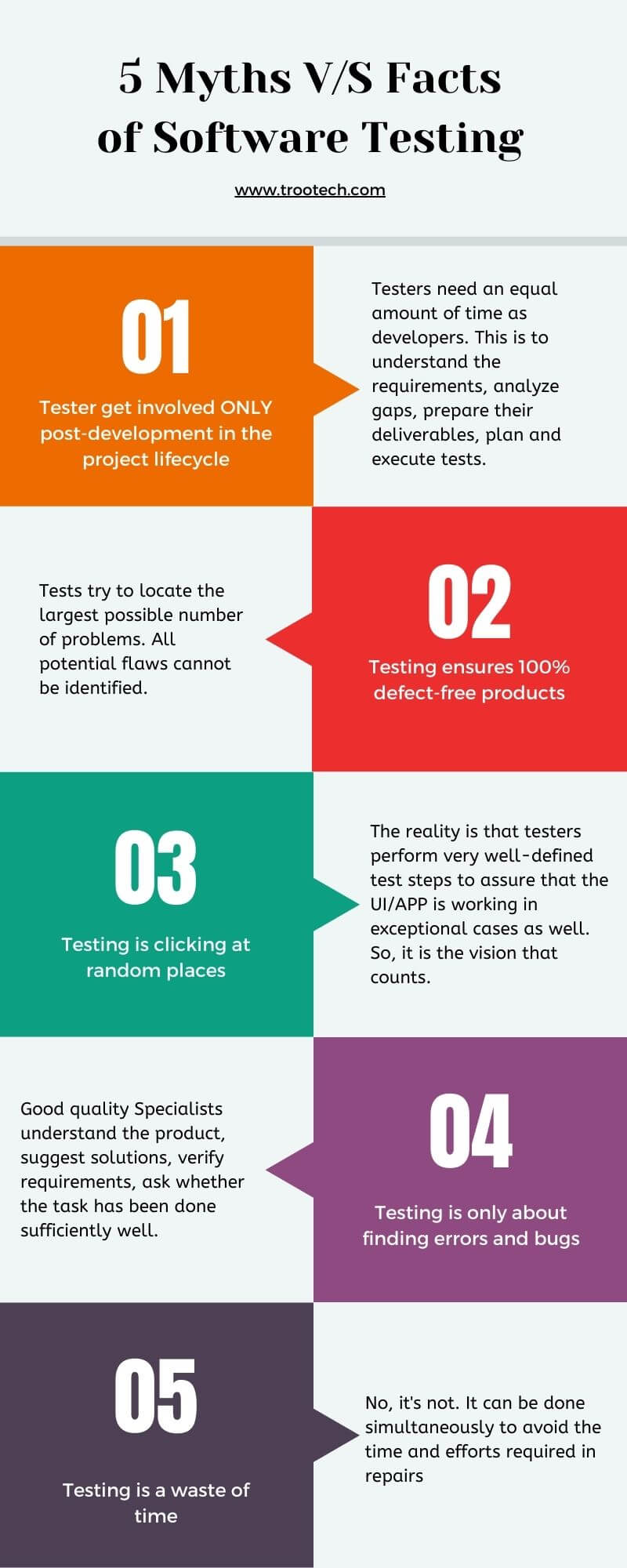The year was 2018.
The country. The U.S.
Can you guess the loss incurred, owing to poor software quality?
No.
Not in million. Not even in billion, But in a trillion.
Poor software quality led to a mounting loss of around US$ 3 Tn in the U.S.
And if you think that these losses are limited to small or mid software apps and websites, think again.
The brunt has been faced even by British Airways, O2 network, Facebook, and more.
In the world of epic software failures, it may seem euphoric to aim for software that your end users are hooked to. However, it is indeed possible with conscious efforts towards software testing.
While there are different types of software testing, it might be confusing to know which testing method to use when. In this blog, we will help you understand the different types of software testing methods for your software.
Which are the Main Types of Software Testing Methods?
Let’s get started with an understanding of different types of software testing methods

Unit Testing:
Unit testing comprises the initial phase of testing, wherein each of the modules is tested on an individual level. Using the unit testing method, both–the developers and testers can separate the modules out for the identification and fixation of the system defects at an early stage. When the errors are identified during the early stage, it becomes easy to offer a highly-performant web app and mobile application to users.
Which are the Types of Unit Testing?
Basically, we can divide unit testing into three categories:
- White Box Testing:
White box testing is also known as glass box testing or transparent testing. In this particular type, developers have to validate the functional behaviour of the software. - Black Box Testing:
It is one of the key types of software testing. Under this method, testers are not aware of the functionality of the software and they test it to identify the structure of the software. - Gray Box Testing:
Gray box testing is a combination of white box testing and black box testing. In this particular testing type, testers partially know about the system functionality and use the method for assessing the performance of the software.
Integration Testing:
ntegration testing is one of the popular types of software testing methods used by professional QAs. In this software testing method, some of the modules of the software are classified together and then tested. The main reason to use the integration testing method is to shed light on the interaction and connection between key software modules, once they have to perform a definite function.
What are the Key Examples of an Integration Testing Type?
The integration testing method differs from the other testing types since its key focus is on the flow of the information or data as well as the interfaces among the modules. The priority in the integration testing is put on the integration of links other than the individual components.
For instance, when an application has three modules, including the login page, delete emails, and mailbox, you will need to check the flow of information between the mailbox and the login module. In this use case, you have to feed the login credentials and then click on the login button to be directed to the mailbox.
Regression Testing:
Regression testing means the testing of the software and checking that the latest update does not have any effect on the performance of the product. Using regression testing, testers can ensure that the new features, functionality, modifications, or bug patches doesn’t derail the performance of the software.
It is important to carry out regression testing for the identification of issues, which might have occurred, owing to the code modification. When you skip regression testing, you might end up with flawy software.
What are the Key Regression Testing Types?
There are basically three types of regression testing:
- Complete Regression:
When you make a significant change in your content, it might end up affecting multiple modules. This change might have a prominent effect on other modules. In order to identify this effect, you can rely on complete regression testing. - Partial Regression:
Testers use partial regression for ensuring that the code performs in a proper manner when multiple modifications are done. In some cases, the units are tested independently without any kind of discrepancy. - Unit Regression:
When you are carrying out unit testing, the code can be tested in isolation. This implies that any kind of dependencies can be tested and are disabled, thereby enabling unit modules to be tested independently without any kind of discrepancy.

Interface Testing:
When it comes to interface testing, it helps to ensure that the user interface functions and features are proper. The user interface testing can enable you to verify that the design elements are in sync. The testers have to check the screens using the controls such as toolbars, menu bars, sizes, content buttons, etc.
In order to carry out interface testing, testers have to carry out multiple test cases using the set of conditions to determine the performance of a system. The interface testing can be conducted in two ways–either a human software tester can do it or through a software program.
What are some of the Best Use Cases of UI Testing?
Below are some of the criteria to look for while carrying out UI testing:
- Check the icon styles
- Determine the consistency of the dialogue boxes
- Identify the data type errors
- Determine the field width
- Check the font size and type
Alpha Testing:
Alpha testing is one of the most popular types of software testing. Alpha testing can be conducted to determine the bugs prior to releasing the software for real users. It is one of the key methods for user acceptance testing. It is known as an alpha testing method as it can be done early on and nearly at the end of the software lifecycle development. It is usually the last stage for testing prior to the software release.
What is the Key Objective of Alpha Testing?
Below are some of the criteria to look for while carrying out UI testing:
- The key objective of alpha testing is to improve the software through the identification of bugs, which can’t be discovered while the previous tests are carried out.
- The alpha testing method can also be used for refining the software and fixing the bugs, which have not been discovered while the previous tests are conducted.
- The alpha testing method also includes customers deep through the process of development.
Ad-hoc Testing:
Ad-hoc testing is a type of informal testing, which can be performed without any proper documentation or planning. In order words, it can be said that ad-hoc testing is an unstructured or random test implemented for breaking the software testing process and identifying the possible errors or defects at the earliest.
Ad-hoc testing uses a technique known as error guessing, which can be carried out by individuals with proper experience for guessing the likely error sources.
What are the Key Ad-hoc Testing Types?
Ad-hoc testing can be categorized into three categories:
- Monkey Testing:
Monkey testing can be performed at the unit testing level. The tester guesses the test cases or data in an entirely random manner for ensuring the software operates without any kind of crashes. - Pair Testing:
In the pair testing method, two users have to work together using the same test environment on a module shared between them. - Buddy Testing:
Using the buddy testing method, a development member and a test member together works on the very module. After the developer completes working on the unit testing methodology, the developer and the tester can collaborate and work on the module.

Beta Testing:
Beta testing is basically performed by real users in the real environment. It is also known as user acceptance testing. The beta version of the application is then released only to a certain number of users and they are asked for feedback. The beta testing enables the minimal risk of product failure and it also offers high quality of the product using customer validation.
Beta testing is the final test performed before you have to ship products to the customers. One of the best benefits of beta testing is that you can get direct feedback from customers.
What are the Key Advantages of Beta Testing?
- Beta testing helps in the reduction of the risk of product failure through customer validation.
- Beta testing also enables a company to test the infrastructure after the launch.
- It also enables and brings improvement in product quality through customer feedback.
- Beta testing is cost-effective when you have to compare it with the other data gathering methods.
- Through beta testing, you can get instant feedback and improve customer satisfaction.
Performance Testing:
Performance testing is the method to evaluate how software or a system operates in terms of stability as well as performance under a specific workload. These are usually carried out for determining the speed, app size, robustness, and reliability of the software.
What are the Key Types of Performance Testing
Ad-hoc testing can be categorized into three categories:
- Load Test:
It creates stimulation to represent the number of virtual users, who might utilize the software and produce analysis about load conditions and realistic usage. - Unit Test:
It triggers the transactional activity for a particular test campaign and isolates the transactions, which could disrupt the system. - Stress Test:
It determines the behaviour of systems when they face peak activity. - Soak Test:
Soak test usually shows the increase in the number of concurrent users and determine the behaviour of the software over a long period of time.
Security Testing:
Security testing is used to identify if the software is under any kind of cyber attack. In addition to this, security testing tests the effect of unexpected or malicious inputs on the operations. Security testing offers enough proof that the data and information of users in the software are kept safe.
What are the Major Security Testing Tools?
- Static application security testing for analyzing the source code when it is at rest.
- Dynamic application security testing for determining the app performance during the runtime.
- Interactive application security testing and hybrid tools for determining if the source code vulnerabilities can be exploited during the runtime.
- Software composition analysis for the management and security of open-source components.
Compatibility Testing:
Compatibility testing can be categorized under non-functional testing and it is carried out on software for checking its running capability on various environments.
What are the Different Types of Compatibility Testing
- Forward Compatibility Testing:
When the compatibility along with the behaviour of specific software or hardware can be checked with a newer version, it is classified as forward compatibility testing. - Backward Compatibility Testing:
When the compatibility as well as the behaviour of specific software or hardware is checked and compared with the older version, it is known as backward compatibility testing.
Usability Testing:
Usability testing is a key testing technique, which can be utilized for the evaluation of the software. To put this into perspective, usability testing can help check the user-friendliness of the software. In addition to this, it also tests the user experience when it has to interact with software.
What are the Major Benefits of Usability Testing?
- Usability testing can save significant time while designing the software.
- The method is one of the best types of software testing for ensuring that the product performs in the designated manner.
- It also helps save a lot of money required for coding or rebuilding the software.
- Usability testing also helps make important changes on the basis of solid data and insights.
Load Testing:
A load test is one of the key types of software testing, which can be performed as a subset of the performance tests. Performance tests can be utilized for the identification of bottlenecks through the stimulation of user queries for detecting the possible malfunctions in the software.
What are the Key Objectives of Load Testing?
- Load testing can be used for checking whether the software can support a number of users at any given time.
- The testing method can also check the maximum operational capability of the software.
- The load testing method can be used to check if the current infrastructure can underpin the interaction of users with the software without any kind of hitch.
- The testing method can be used to check the durability of the website or an app when it is challenged through peak user load..
What are the Best Practices for Software Testing?
In order to launch software confidently, you have to keep up an ace software testing game. Using a good testing approach, you can ensure that your software is performing with optimum capacity and capability even if you are starting a project from scratch or refactoring one.
Also, among the different types of software testing methods, you can identify the best one by seeking consultation from a reliable software development firm.
Continuous Testing:
Test every build as soon as it becomes available. Also, it can be validated in realistic test environments.
Configuration Management:
Allow access to your team to assets such as requirements, code, test scripts, design documents, and test results.
Service Virtualization:
Simulate systems and services for reducing the dependencies and complete the testing at the earliest.
Bug Tracking:
Use automated tools for testing and tracking defects and measuring the scope.
Metrics and Reporting:
Build a reporting and analytics channel for enabling your team members to share their status, test results, and goals.


